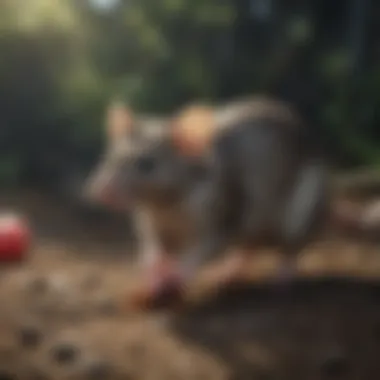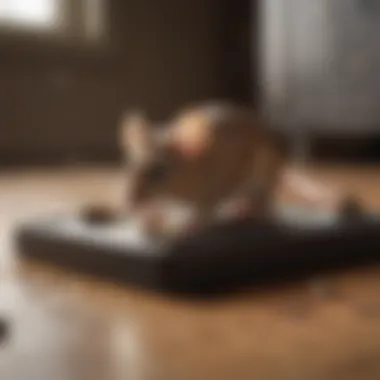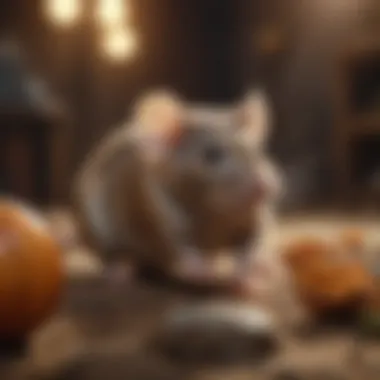Expert Strategies for Effective Mouse Trapping


Intro
Trapping mice effectively requires an understanding of the animal itself. Before planning the strategy for capture, it is vital to consider the biology and behavior of the mouse. Knowledge in these areas informs the methods a person may choose, improving both efficiency and humanness. This article dissects various methods of trapping mice, delving deep into the traits of these creatures to enhance trapping outcomes.
Animal Overview
Mice are small rodents that belong to the family Muridae. They are often seen indoors, sparking the need for removal. Understanding their classification aids in recognizing the specific species that might invade homes. Common species include the house mouse (Mus musculus) and the field mouse (Apodemus factionalis).
Common Names
- House mouse
- Field mouse
- Deer mouse
Scientific Classification
- Kingdom: Animalia
- Phylum: Chordata
- Class: Mammalia
- Order: Rodentia
- Family: Muridae
- Genus: Mus
- Species: Mus musculus (House Mouse)
Geographic Range
Mice are found worldwide but are more common in urban areas where food and shelter are abundant. Their adaptability allows them to thrive in various climates, from temperate regions to tropical areas. This wide distribution makes it essential for homeowners to be prepared for potential interactions with these creatures.
Behavior and Social Structure
Mice exhibit social behavior, living in groups that offer protection and promote mating. Understanding their social habits is crucial for effective trapping strategies.
Social Behavior
Mice thrive in a communal environment. They can form colonies, facilitating mating and resource sharing. This social structure allows for an increased survival rate.
Communication
Mice communicate through a series of vocalizations and scents. They produce ultrasonic sounds that are inaudible to humans, which play a role in social interaction and territorial behavior.
Mating and Reproduction
Breeding can occur year-round. Female mice can produce several litters annually, each containing three to twelve young. This high reproductive rate emphasizes the importance of quick and effective trapping methods to control populations.
Habitat and Ecosystem
Mice are versatile in their habitat preferences. They adapt to various environments, making them resilient in both rural and urban ecosystems.
Natural Habitat
They prefer places with easy access to food and shelter. Common habitats include fields, forests, and human dwellings. These settings provide all they need for survival.
Food Sources and Diet
Mice are omnivorous, consuming seeds, fruits, and small insects. Their adaptability in diet allows them to thrive in diverse settings.
Role in Ecosystem
Mice play a significant role in the ecosystem. They serve as prey for various predators and assist in seed dispersal, thus contributing to the health of their environments. Understanding their ecological role can aid in developing humane trapping methods, ensuring a balance between wildlife and human habitation.
Knowledge of mice behavior and ecology fosters humane and effective trapping strategies.
Understanding Mouse Behavior
Understanding the behavior of mice is crucial for effective trapping. Recognizing why they intrude into our spaces and their habits can significantly influence the methods one chooses to capture them. This knowledge aids in selecting appropriate traps, positioning them wisely, and implementing effective bait strategies. Knowledge is power when it comes to ensuring both efficiency and humanity in trapping.
Why Mice Intrude
Mice often invade human habitats for several reasons. Their primary motivators include the search for food, shelter, and warmth. Mice are attracted to easily accessible food sources, which can include crumbs, pet food, and garbage. They are also drawn to places with ideal shelter, such as attics, basements, and even between walls. These environments provide safety from predators and harsh weather conditions.
Additionally, during colder months, mice seek warmth to survive. This is when they are most likely to enter homes. The crucial point here is that understanding these reasons allows individuals to better anticipate and mitigate intrusions.
This involves not only trapping but also implementing preventive measures to deter mice from entering properties in the first place.
Mouse Habits and Patterns
Mice have distinct habits and patterns that can greatly affect trapping success. They are nocturnal, often more active at night when the environment is less busy. This means traps should ideally be set during these hours for maximum effectiveness. When setting traps, consider the routes they commonly take. Mice tend to follow walls and edges to navigate, making placement along these points more effective.


Furthermore, mice are social creatures. A single mouse can indicate a larger infestation. Mice can reproduce rapidly, leading to increased challenges if not addressed quickly. Understanding these habits and social structures can inform strategies to reduce the mouse population effectively.
In summary, grasping the underlying reasons for mice intrusions, along with their habits, can enhance trapping efficiency. This foundational knowledge sets the stage for selecting the right traps and bait, and strategically placing them to optimize success.
Choosing the Right Trap
Choosing the right trap is essential for effective mouse control. Mice are adaptable creatures and can be challenging to manage. Therefore, selecting an appropriate trap influences both capture success and humane treatment. Each trap type has its own set of perks and downsides, making it crucial to evaluate the options based on personal preferences and circumstances.
When deciding on a trap, consider factors such as the level of infestation, safety for pets and children, and your moral stance on animal confinement. In addition, the specific features and functioning of each trap can greatly affect the trapping process. Understanding these elements will help tailor your approach and strategies to capture mice efficiently.
Snap Traps
Snap traps are among the most traditional and commonly used mouse traps. They utilize a spring mechanism that delivers a quick, lethal blow to the mouse. Their design enables efficient trapping, often achieving faster results than other methods. Snap traps are quite effective when placed in high-traffic areas where mice frequently travel.
Advantages of Snap Traps:
- High capture rate due to direct contact.
- Easy to set up and use.
- Affordable and widely available at stores.
Considerations:
- Must be checked frequently to avoid prolonged suffering if a mouse is trapped and injured.
- Needs careful positioning to ensure safety from unintended catches of non-target animals.
Glue Traps
Glue traps operate on a simpler principle by using a sticky surface to catch mice. When a mouse runs over the glue, it becomes stuck and cannot escape. These traps can be effective in some situations, especially in areas where mice are likely to walk over them.
Advantages of Glue Traps:
- Inexpensive and readily accessible.
- No baiting required, which simplifies the trapping process.
Considerations:
- Can lead to prolonged suffering for captured mice, raising ethical concerns.
- Not suitable for outdoor use as weather can affect glue’s effectiveness.
Live Traps
Live traps are designed to catch mice without hurting them. These traps allow for safe capture, making it possible to release the mouse afterward. This method appeals to those who prefer humane methods and want to avoid killing the animals.
Advantages of Live Traps:
- Encourages humane practices by not harming the captured mouse.
- Allows for relocation of the mouse to a safe environment.
Considerations:
- Requires regular checks to prevent stress or harm if the mouse is left inside for too long.
- Legal aspects of relocation may vary by location; some areas have restrictions on releasing captured wildlife.
Electronic Traps
Electronic traps use a high-voltage shock to quickly kill the mouse. They are often considered modern solutions for pest control, combining efficiency with ease of use. These traps can also be effective for someone dealing with a larger rodent problem.
Advantages of Electronic Traps:
- Fast and humane method of capturing mice.
- Allows for less frequent trap checking due to automatic kill systems.
Considerations:
- Initial cost may be higher compared to traditional traps.
- Requires batteries or a power source, which can limit usage in some areas.
Effective Bait Selection
Selecting the right bait is crucial in the process of effectively trapping a mouse. Bait serves as a lure, enticing mice into the traps we set. Understanding their preferences and habits can significantly increase the likelihood of a successful capture. Mice possess keen senses of smell and taste, making the choice of bait a fundamental aspect of any trapping strategy. If the bait is unappealing, the mouse will likely avoid the trap altogether.
Moreover, the benefits of effective bait selection extend beyond mere attraction. The right bait can reduce the time traps are left in place, thereby minimizing stress on the targeted animals. It can also enhance the overall efficiency of your trapping efforts, making it a vital component in both household and wildlife management practices. It's essential, therefore, to consider the specific kinds of baits that may yield the best results.
Common Baits
When it comes to common baits for mouse traps, several options stand out.
- Peanut butter: This is often regarded as one of the most effective baits. Its strong scent and sticky texture appeal to mice, making it difficult for them to remove without triggering the trap.
- Cheese: Although popularized by cartoons, cheese can work. Mice are attracted to the fat in cheese, though it may not be as effective as other options.
- Grains and seeds: They are natural food sources for mice and can be highly effective. Sunflower seeds or oats offer both scent and texture that can lure mice in.
- Fruits: Small pieces of fruit, such as apples or bananas, can also be used. They provide a sweet aroma that is hard for mice to resist.


Utilizing these common baits increases the likelihood of setting the perfect trap for your mouse issue.
Specialized Bait Techniques
Using specialized bait techniques can further enhance your success rate in trapping mice. These involve strategies that go beyond merely placing food in traps.
- Layering baits: Sometimes, using a combination of baits can be more effective than a single item. Mixing grains with peanut butter or wrapping bait in something enticing can draw in even cautious mice.
- Enhanced scents: Adding a drop of vanilla extract to peanut butter can intensify its appeal. This simple modification can be enough to attract more mice to the trap.
- Timing the baiting: Baiting traps at night, when mice are most active, can increase the chances of a catch. Set traps before dusk to optimize the trapping window.
- Using scent trails: If you suspect where mice are coming from, creating a scent trail leading to the trap can lure them in. You can use small bits of bait to form a trail that leads right to the trap.
In summary, effective bait selection combines an understanding of mouse preferences with creative strategies to ensure your trapping efforts yield success.
Strategic Trap Placement
Strategic trap placement is a crucial component in the effectiveness of mouse trapping methods. Understanding where to position traps can significantly enhance the likelihood of capturing mice. It is not enough to simply set a trap; the strategy behind its placement can make the difference between success and failure.
Identifying High Traffic Areas
To optimize trap placement, it is essential to identify high traffic areas frequented by mice. Mice tend to follow specific paths due to their cautious nature. Here are some key considerations to keep in mind:
- Along Walls: Mice are creatures of habit. They often travel close to walls to feel secure. Placing traps along these routes increases the chances of capturing them.
- Near Food Sources: Mice are attracted to food. Placing traps near pantries, kitchens, or any area where food is stored can be effective.
- Entry Points: Check for any gaps or cracks where mice might enter. Place traps near these entryways.
Identifying these high traffic areas requires observation. Look for mouse droppings, gnaw marks, or nesting materials to locate their paths. Do not underestimate the importance of precision in this step.
Environmental Considerations
Environmental factors play a significant role in trap placement. The surrounding conditions can influence mouse behavior and trap effectiveness. Here are some environmental aspects to consider:
- Lighting: Mice prefer dark and concealed areas. Avoid bright, open spaces for trap placement; instead, look for shaded, less disturbed corners.
- Human Activity: Avoid placing traps in areas with high human traffic. Mice are more likely to venture out when human activity is low.
- Climate Conditions: Seasonal changes can alter mouse behavior. For instance, during colder months, mice may seek shelter in homes more than in warmer periods. Adjust trap placement accordingly.
Effective trap placement is not merely about the traps themselves; it involves understanding the entire environment where they are being used.
By carefully considering these factors, one can improve the chances of success in trapping mice. Strategic trap placement is not just a simple task; it requires thorough analysis and understanding of the mouse’s habits, as well as the surrounding environment. Every detail matters when it comes to effectively capturing these pests.
Monitoring and Maintenance
Monitoring and maintenance plays a critical role in the effectiveness of any mouse trapping strategy. After establishing traps, regular checks are essential to ensure they function as intended. Consistent monitoring allows for quick identification of captured mice or the need for modifications in your trapping approach. This process enhances your success rate, making it more likely to control or eliminate mouse populations effectively.
Checking Traps Regularly
One of the most important aspects of monitoring is checking traps at regular intervals. Frequent checks are vital for several reasons:
- Ethical Considerations: It is crucial to minimize suffering for trapped animals. Regular checks ensure that captured mice do not endure undue stress or pain.
- Trap Efficiency: An unattended trap can become ineffective if not monitored. For example, if a trap is blocked or damaged, it needs immediate attention.
- Reflecting Mouse Activity: The frequency of captures can reveal patterns in mouse activity. Understanding these shifts can help in further refining placement and bait selection.
How often should you check the traps? It often depends on the trapping method employed and the severity of the mouse issue. For instance, snap traps may require checking multiple times a day, especially in infested areas, while live traps could be checked once or twice daily.
Replacing Bait
Replacing bait is another crucial element of the monitoring process. Bait quality can significantly affect trapping success. Mice are less likely to approach a trap with old or spoiled bait. To ensure maximum attractiveness, apply these considerations:
- Use Fresh Bait: Always use new bait during each trap monitoring session. Fresh scents are more likely to attract mice.
- Adjust Bait Choices: If the bait consistently goes untouched, experiment with different options to find what resonates. Peanut butter, sunflower seeds, or dried fruits could be effective choices.
Keep track of what works best in your specific environment by jotting down notes about bait usage and lure success over time.
Regularly monitoring traps and replacing bait is not just about catching mice; it is about enhancing your strategy and ethical standards in pest control.
Ethical Considerations
When addressing mouse trapping, ethical consideratons are paramount. As we manage mouse populations, we must also consider the welfare of these animals. Trapping should ideally minimize stress and suffering while effectively managing any infestation. Failing to adhere to ethical practices can lead to needless harm and distress, both for the captured mice and the ecosystem.
Humane Trapping Practices
Humane trapping prioritizes the safety and well-being of the mouse. Several approaches help achieve this goal. Live traps are designed to capture mice without causing any harm. These traps allow for the safe relocation of the captured individuals, which can help maintain local ecosystems without unnecessary deaths.
In addition, using appropriate bait can reduce the time mice spend in traps, thus lowering their stress levels. It's important to regularly check live traps to minimize the duration in captivity. Avoid using traps that might injure the mice, such as glue traps or poorly designed snap traps. The aim should always be to capture the animal alive, enabling a more humane resolution.
Key Point: Always handle traps with care and consider the mouse's welfare during the capturing process.
Local Regulations and Guidelines
Operating within the framework of local regulations is essential when dealing with mouse trapping. Various regions have specific laws regarding how to trap and relocate mice. Familiarizing oneself with these rules can prevent potential legal issues and promote ethical pest control.


Regulations may dictate the types of traps allowed, the treatment of captured mice, and the locations where relocation is permissible. These rules aim to protect both wildlife and human interests. Additionally, adhering to local guidelines fosters a responsible approach to pest management.
To ensure compliance:
- Research local wildlife protection laws.
- Consult with local pest control professionals or animal welfare organizations.
- Regularly update your knowledge as regulations may change over time.
Understanding these regulations can significantly enhance the trapping experience, aligning the process with ethical practices. Being responsible can lead to better relationships within the community and a more effective approach to managing mouse populations.
Post-Capture Procedures
Post-capture procedures are essential after successfully trapping a mouse. These steps not only ensure humane treatment of the animal but also help maintain a safe and clean living environment. Proper handling, disposal, and relocation methods are crucial in minimizing potential health risks and ensuring that the captured mice do not return to your space.
Handling Captured Mice
Once a mouse is captured, the first priority should be to handle it as gently and cautiously as possible. Mice are frightened creatures and can become stressed very easily. Wearing gloves is advisable for safety reasons; this helps prevent any potential diseases that might be transmitted through direct contact. It's important to approach the trapped mouse calmly to avoid startling it, which can lead to injury.
- Transporting the Trap: If you are using a live trap, consider covering it with a cloth to minimize external stressors. This may help soothe the mouse during the transport to a relocation site.
- Checking the Trap: Regular checks on the traps during the capture phase help minimize suffering. Letting the mouse stay trapped for extended periods can lead to stress and health issues.
- Understanding Behavior: Recognizing that mice communicate through body language can also help. A calm demeanor will likely keep the trapped mouse from agitated behaviors, allowing for an easier move afterwards.
Disposal and Relocation
The decision on what to do with a captured mouse should be made with care. Both disposal and relocation should focus on humane practices.
- Relocation: If you choose to relocate the mouse, transport it at least a mile away from your home to reduce the chance of it finding its way back. Release the mouse in a suitable environment, ideally one that provides cover and food sources like fields or wooded areas.
- Disposal: If relocation is not feasible or the mouse is deceased, proper disposal is necessary. Research local regulations as they might dictate specific guidelines for disposal. In many areas, it is recommended to use sealed plastic bags and dispose of them in the household waste.
Ultimately, these post-capture actions contribute significantly to a more responsible and ethical approach to trapping mice. By dealing with captured mice in a considerate manner, individuals can lessen the negative impacts on animal welfare and reduce the potential risks to human health and safety.
"Humane treatment during post-capture is not merely a practice but a responsibility we share towards all living beings."
These considerations highlight the significance of mindful post-capture procedures in the broader context of effective mouse trapping.
Preventive Measures
Preventive measures are crucial in effective mouse control. These strategies not only lead to a significant reduction in mouse sightings but also help create a long-term solution. By proactively addressing the factors that attract mice to your home, you reduce the need to resort to traps later. Instead of just focusing on trapping, the goal should be to make your space less inviting to these creatures from the start.
Effective preventive measures are often easier and less stressful than dealing with a full-blown mouse infestation. They save both time and resources and foster a more tranquil living space. Furthermore, preventing entry and maintaining cleanliness goes hand-in-hand with humane trapping practices, ensuring a comprehensive approach.
Sealing Entry Points
Mice can squeeze through very small gaps. Even a hole as tiny as a dime can serve as an entrance. Thus, sealing entry points is essential. Inspect your home for possible entry points such as cracks in walls, gaps around doors, and holes in window screens.
To seal these entry points, you can use materials such as:
- Steel wool: This is effective for small holes; mice cannot gnaw through it.
- Caulk: Useful for sealing cracks and gaps.
- Expanding foam: Works well for larger holes where insulation is necessary.
It's also wise to focus on areas crucial to rodent ingress, such as:
- Basements: Regularly check vents and pipes.
- Kitchens: Inspect areas around plumbing and appliances.
- Attics: A potential harbor for mice, so inspections should be routine.
Taking time to fortify your home against entry will considerably reduce the chances of mice getting inside.
Maintaining Cleanliness
A clean environment is less attractive to mice. Maintaining cleanliness helps eliminate food sources and nesting materials that might draw them in. Here are some vital steps in your cleanliness regimen:
- Store food properly: Keep food in sealed containers. Mice are opportunistic feeders and can consume various types of food.
- Clean up crumbs: Regularly sweep floors and wipe down kitchen surfaces to avoid leftover food.
- Declutter: Reducing clutter decreases hiding spots for mice. This improves not only your space but makes it less desirable for rodents.
Furthermore, maintaining cleanliness in outdoor areas also plays a role. Gardens that are overgrown can provide hiding areas, while bird feeders can attract mice. Regular maintenance of outdoor spaces ensures that mice do not find a comfortable habitat nearby.
End
The conclusion plays a crucial role in synthesizing the informative content presented throughout this article on trapping mice. It serves to summarize the essential strategies and practices that have been discussed, reinforcing their significance in effective mouse management.
Summary of Effective Strategies
The strategies highlighted in this article emphasize a balanced approach to trapping. The emphasis on understanding mouse behavior allows for more targeted trapping techniques. Key points include:
- Selecting the appropriate trap type. Knowing when to use snap traps, glue traps, live traps, or electronic traps is fundamental. Each has its own merits and suitable scenarios for use.
- Choosing effective bait. Understanding what attracts mice ensures a greater chance of successful trapping.
- Strategic placement of traps. Identifying areas of high mouse activity and considering environmental conditions can maximize trapping success.
- Regular monitoring and maintenance. Checking traps frequently ensures that any captured mice are dealt with promptly, reducing suffering and maintaining hygiene.
- Implementing preventive measures. Sealing entry points and maintaining cleanliness are key components in avoiding future infestations.
Each of these elements intertwines and contributes to a comprehensive trapping strategy that is both humane and effective.
Future Considerations and Practices
As we look ahead, there are various considerations that can enhance mouse trapping practices. Continuous adaptation of techniques based on the latest research in rodent behavior and technology can yield improved trapping outcomes. Here are some points to consider:
- Investing in newer trap technologies. Electronic traps, which offer quick and humane solutions, are worth exploring. Research and developments in this area should be monitored.
- Exploring ecological approaches. Understanding the ecological impact of trapping and pest control can lead to more sustainable practices that align with wildlife preservation efforts.
- Community education and awareness. Promoting knowledge about humane trapping and preventive measures is essential, especially in urban areas where human-animal interactions are frequent.
By prioritizing humane approaches and ongoing education, we contribute to a more balanced coexistence between humans and mice.







